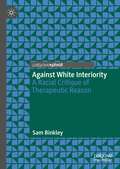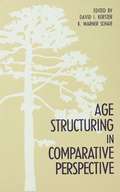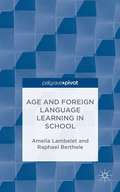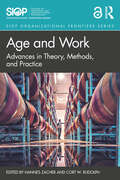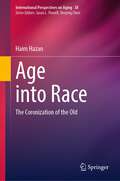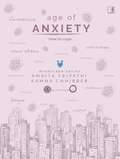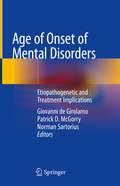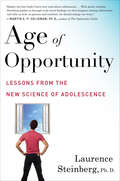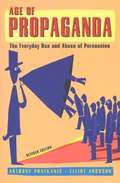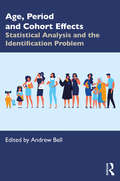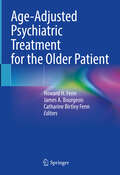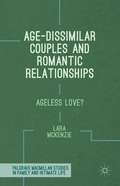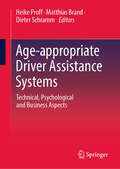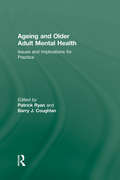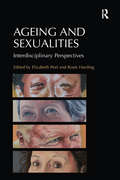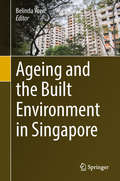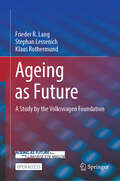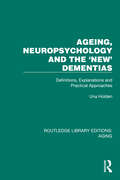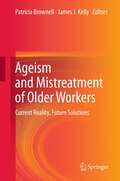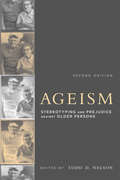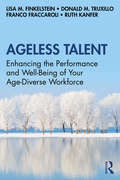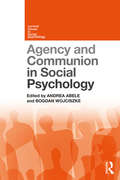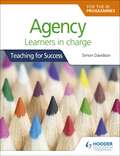- Table View
- List View
Against White Interiority: A Racial Critique of Therapeutic Reason
by Sam BinkleyThis book presents a bold critique of the new racial sensibility that has attained global prominence following the police murder of George Floyd. Through a set of managerial and therapeutic discourses, this new sensibility describes the inner racial life of white subjects, inducing them to adopt a therapeutic attitude toward deeply interiorized white emotions and conflicts. In so doing, the new racial sensibility promises to remake whiteness in the image of the self-aware racial ally. However, such an appeal, it is argued, serves the subtle function of the preservation of white racial dispositions, and the reproduction of the very racism it sets out to transform. Adopting a critical lens derived from Michel Foucault’s analysis of sexuality, together with an engagement with sociological, psychoanalytic and phenomenological reflections on shame as a racial affect, a critique of white interiority considers alternative frames through which white anti-racist subjection might be imagined.
Against the Wind
by Howard Scott Madeleine Gagnon Phyllis AronoffIs an artist born, or rather, created by experience? From the moment in childhood when he is forced to take drastic action to defend his adoptive mother from a violent assault - the only maternal figure that he has ever known - it is evident that the life of Joseph Sully-Jacques is to be no ordinary life, and one marked by sorrow and adversity.Unable to cope with or even recognize the residual effects of his trauma in adolescence, Joseph retreats into an increasingly abstract world, one in which he must confront what he calls his "visions." And when he hears of the death of his natural mother, this brings to the surface memories he had hoped were buried deep within him, and precipitates the form of various crises to come, particularly as he discovers and makes use of the artistic abilities revealed to his family during his psychiatric evaluation.After many more hardships, the young man does find meaning to the absurdities of life, ironically in the asylum, where he meets a virtuoso pianist whose condition prevents her from continuing to exercise her talents. They heal together through their mutual love, which will soon subsist upon nothing but memory and absence. During mournful years of raising his son alone, in his extensive adversaria, Joseph sets out to reconcile the contradictory themes in his life, including abandonment, madness, love, and death.In spare, lucid prose, and in a style reminiscent of André Gide, Madeleine Gagnon invites the reader to experience the creation and development of an artist "in his own words" - Joseph's gelid journal entries that are to become emphatic poetic laments - in a novel that chronicles the extreme destitution of Quebec in the years before World War Two and in abstract developing forms of artistic expression after years of uncertainty and loss.
Age Structuring in Comparative Perspective (Social Structure and Aging Series)
by David I. Kertzer K. Warner SchaieThis volume studies age as a basis for social organization by uniting research from the social science disciplines while implementing both cross-cultural and historical perspectives. The contributors, a distinguished interdisciplinary group of scholars, advance our understanding of age structuring by relating the changing societal level processes and individual aging experiences, and examining retirement practices, age and power in society, and cultural conceptions of age.
Age and Foreign Language Learning in School
by Amelia Lambelet Raphael BertheleThis book discusses the empirical studies on how biological age influences foreign language learning in school. It provides a succinct overview of a complex field for both experts and researchers interested in the teaching and learning of foreign languages.
Age and Work: Advances in Theory, Methods, and Practice (SIOP Organizational Frontiers Series)
by Cort W. Rudolph Hannes ZacherThe edited volume Age and Work: Advances in Theory, Methods, and Practice presents a systematic collection of key advances in theory, methods, and practice regarding age(ing) and work. This cutting-edge collection breaks new ground by developing novel and useful theory, explaining underutilized but important methodological approaches, and suggesting original practical applications of emerging research topics. The book begins with a prologue by the World Health Organization’s unit head for aging and health, an introduction on the topic by the editors, and an overview of past, current, and future workforce age trends. Subsequently, the first main section outlines theoretical advances regarding alternative age constructs (e.g., subjective age), intersectionality of age with gender and social class, paradoxical age-related actions, generational identity, and integration of lifespan theories. The second section presents methodological advances regarding behavioral assessment, age at the team and organizational levels, longitudinal and diary methods, experiments and interventions, qualitative methods, and the use of archival data. The third section covers practical advances regarding age and job crafting, knowledge exchange, the work/nonwork interface, healthy aging, and absenteeism and presenteeism, and organizational meta-strategies for younger and older workers. The book concludes with an epilogue by an eminent scholar in age and work. Written in a scientific yet accessible manner, the book offers a valuable resource for undergraduate and graduate students, academics in the fields of psychology and business, as well as practitioners working in the areas of human resource management and organizational development.
Age into Race: The Coronization of the Old (International Perspectives on Aging #38)
by Haim HazanAge into Race is a socio-anthropological essay on the repercussions of the Covid-19 pandemic on the cultural status of the old. As the worldwide horrors of the Corona era have since been publicly repressed, the text is geared to revisit and relive the tenor of that time while considering its latent revolutionary aftermath. There was wide agreement that Covid-19 policies targeted older people as a risk group in need of protection, setting it apart from the rest of society. Yet, paradoxically, long-term facilities for older people effectively became Covid-19 death traps. What kind of abandonment propelled this apparent contradiction? This book provides an answer by looking at ageist practices regarding Covid-19 triaging, lockdowns and distancing that affected older people around the world, devising Covid-19 as an inevitable "problem of the elderly" and, by implication, instating and categorizing "the elderly" as a public problem to be bio-politically managed and wrought. The Covid-19 pandemic and its concomitant "state of emergency" triggered an accelerated transmutation of customary ageism into emergent racism, spelling a fatal switch to designating the old as bearers of "bare" life unworthy of human living, thus turning old age from a seemingly cultural category to a socially fabricated viral menace of nature. The book tracks down the process through which the "Coronization" of culture legitimized and impelled a further stigmatization of old age beyond mere ageism to sheer racism. Thus, this transmutation, while compromising their autonomy and subjectivity via imposed lockdowns, social isolation, excommunication and selective discrimination rendered the old a race apart. Subsequently, the moral panic invoked by the specter of the pandemic transformed the social perceptions of later life from a containable social problem to an unbridled public hazard that summoned total measures presented as bureaucratically regimented regulations that dehumanized its victims with impunity.
Age of Anxiety: How to Cope
by Amrita Tripathi Kamna Chhibber&‘What does it mean when someone says they have Anxiety?&’&‘I&’m stressed and nervous all the time, do I have Anxiety?&’&‘Will I ever get better?&’These are some of the questions we want to answer in this book. Is this the Age of Anxiety? Well, how could it not be – when so many millions of us feel that persistent combination of heart palpitations, impending doom, dread, even lack of control, as one of our contributors describes it. The question is, what can we do about it?Through this book we will learn how to distinguish between anxiety as 'an attack of the nerves' or something that will come and go, and Anxiety as a disorder, which will need treatment, including possibly therapy or medication. The conversations are even more pertinent given the global Covid-19 pandemic, prolonged periods of social isolation and an increased focus on mental health and wellness. We learn from coping with Anxiety Disorders, sharing their journey to healing, explaining exactly what would have helped them along the way, as they seek to bust common myths and misconceptions.
Age of Onset of Mental Disorders: Etiopathogenetic and Treatment Implications
by Norman Sartorius Giovanni De Girolamo Patrick D. McGorryThis book presents a thorough and critical review of current knowledge about the age of onset of mental disorders. The opening chapters offer information about the impact of the age of onset on the clinical picture, course, and outcome of physical illnesses, and about the neurobiological implications and correlates of different ages of onset. The impact and correlates of the ages of onset of all the most important mental disorders are then discussed in detail by internationally renowned scientists. The background to the book is the recognition that a better understanding of age of onset makes it possible to estimate the lifetime risk of disorders, helps to elucidate pathogenesis, and facilitates efficient, targeted clinical management. The book will be of value for clinicians, mental health professionals, mental health researchers, epidemiologists, and different stakeholders in the mental health field.
Age of Opportunity
by Laurence SteinbergA leading authority draws on new research to explain why the adolescent years are so developmentally crucial, and what we must do to raise happier, more successful kids.Adolescence now lasts longer than ever before. And as world-renowned expert on adolescent psychology Dr. Laurence Steinberg argues, this makes these years the key period in determining individuals' life outcomes, demanding that we change the way we parent, educate, and understand young people.In Age of Opportunity, Steinberg leads readers through a host of new findings -- including groundbreaking original research -- that reveal what the new timetable of adolescence means for parenting 13-year-olds (who may look more mature than they really are) versus 20-somethings (who may not be floundering even when it looks like they are). He also explains how the plasticity of the adolescent brain, rivaling that of years 0 through 3, suggests new strategies for instilling self-control during the teenage years. Packed with useful knowledge, Age of Opportunity is a sweeping book in the tradition of Reviving Ophelia, and an essential guide for parents and educators of teenagers.
Age of Propaganda: The Everyday Use and Abuse of Persuasion
by Elliot Aronson Anthony H. PratkanisAmericans create 57% of the world's advertising while representing only 6% of its population; half of our waking hours are spent immersed in the mass media. Persuasion has always been integral to the democratic process, but increasingly, thoughtful discussion is being replaced with simplistic soundbites and manipulative messages. Drawing on the history of propaganda as well as on contemporary research in social psychology, Age of Propaganda shows how the tactics used by political campaigners, sales agents, advertisers, televangelists, demagogues, and others often take advantage of our emotions by appealing to our deepest fears and most irrational hopes, creating a distorted vision of the world we live in. This revised and updated edition includes coverage of the Clinton/Lewinsky scandal, recent election campaigns, talk radio, teen suicide, U. F. O. abductions, the Columbine shootings, and novel propaganda tactics based on hypocrisy and false allegations.
Age, Period and Cohort Effects: Statistical Analysis and the Identification Problem
by Andrew BellAge, Period and Cohort Effects: Statistical Analysis and the Identification Problem gives a number of perspectives from top methodologists and applied researchers on the best ways to attempt to answer Age–Period–Cohort related questions about society. Age–Period–Cohort (APC) analysis is a fundamental topic for any quantitative social scientist studying individuals over time. At the same time, it is also one of the most misunderstood and underestimated topics in quantitative methods. As such, this book is key reference material for researchers wanting to know how to deal with APC issues appropriately in their statistical modelling. It deals with the identification problem caused by the co-linearity of the three variables, considers why some currently used methods are problematic and suggests ideas for what applied researchers interested in APC analysis should do. Whilst the perspectives are varied, the book provides a unified view of the subject in a reader-friendly way that will be accessible to social scientists with a moderate level of quantitative understanding, across the social and health sciences.
Age-Adjusted Psychiatric Treatment for the Older Patient
by James A. Bourgeois Howard H. Fenn Catharine Birtley FennThis book offers practical age-adjusted recommendations to treat the most common psychiatric symptoms and syndromes in the geriatric patient. The principles described here are not new; advice for prescribing to the aging patient has always been to “start low, go slow.” This book fleshes out that dictum based on research evidence, clinical experience, and trends in the literature. An age-adjusted approach endorses medication interventions when needed as part of a comprehensive treatment plan. A combination of psychotherapeutic interventions, non-pharmacological modalities, and judiciously managed medications can improve quality of life and minimize risks inherent in pharmacotherapy applied to aging physiology.Age-Adjusted Psychiatric Treatment for the Older Patient is divided into five sections, covering the foundations of evaluation and treatment, neurocognitive disorders, psychiatric syndromes, therapeutics and interventions, and special topics. Each chapter begins with a complex case example that illustrates the topic. It then reviews current evidence-based evaluation and treatments. Age-adjusted recommendations, distilled from the literature, are offered at the end of each chapter. The intent is to provide actionable advice to supplement, but not supplant, good clinical judgement, which can improve quality of life by managing psychiatric symptomatology while averting untoward results.This volume is an essential guide for experienced clinicians as well as trainees across many health care disciplines, both generalists and geriatric specialists, who all see increasing numbers of aged patients with psychiatric symptomatology.
Age-Dissimilar Couples and Romantic Relationships
by Lara MckenzieIn recent years, there has been a widespread fascination with age-dissimilar, heterosexual romantic relationships. This interest is not new - these types of couples have been featured in Western media for decades, even centuries - yet qualitative research into such relationships has been limited. This book examines how the romantic relationships of age-dissimilar couples are understood. Based on a range of interviews, McKenzie argues that historical shifts toward greater personal autonomy in partner selection, within relationships, and in marriage and relationship dissolution have been greatly overstated. Through her focus on age-dissimilar couples, whose increasing prevalence have often been seen to be part of this shift, she suggests that these relationships are an avenue throughwhich shared cultural understandings of relatedness, as well as individualism, might be further analysed. McKenzie argues for an approach that emphasises cultural continuity, and which accounts for complexity and contradiction in how age-dissimilar relationships and romantic love are understood. Examining key issues of kinship, ageing and emotion, Age-Dissimilar Couples and Romantic Relationships will appeal to scholars of Cultural and Social Anthropology, Family Studies and Sociology.
Age-appropriate Driver Assistance Systems: Technical, Psychological and Business Aspects
by Dieter Schramm Heike Proff Matthias BrandPeople in highly developed countries are getting older and older. They want to be mobile in old age, but often have problems in road traffic. Even though they often pay a premium for age-appropriate products that increase safety, the demand for driver assistance systems among older drivers has so far been low. This book summarises the results of the ALFASY (ALtersgerechte FAhrerassistenzSYsteme) project, in which an acoustic driver assistance system is being developed and built to meet the needs of the steadily growing group of older drivers. Technical, psychological and economic aspects were investigated.
Ageing and Older Adult Mental Health: Issues and Implications for Practice
by Patrick Ryan Barry J. CoughlanThis book examines the issues and implications that mental health professionals face when dealing with ageing and older adults. The book focuses on the biological, psychological and cultural influences that impact on the work of mental health practitioners who work with this client group. Based on current empirical research and evidence-based practical issues this book explores topics including: ageing and dementia elder abuse caring for older adults depression and ageing the paradox of ageing how older adults are key to the success of future generations. Throughout the book the contributors emphasise the notion of ‘healthy ageing,' and the importance and significance of this concept as part of the life-cycle process. As such Ageing and Older Adult Mental Health will be key reading not only for mental health professionals, but also for those involved in policy making for older adults.
Ageing and Sexualities: Interdisciplinary Perspectives
by Elizabeth Peel Rosie HardingThis book showcases developments in theory, research and practice regarding sexuality and ageing, considering the differences as well as similarities between and among ageing heterosexual and LGBT older people. Identifying the questions central to future social scientific research on ageing and sexuality, it focuses on the important, emerging dimensions of sexuality and ageing: embodiment, the diversification of the ageing context and the intersections of care and sexuality. With attention to the different forms of sexualities, particularly at their intersection with gender, this volume explores the importance of spatial and relational contexts, whether individual, residential or virtual, with authors offering studies of online dating, sexuality in the context of residential care and the relationship between sexuality, legal frameworks and social policy. Interdisciplinary in scope and offering the latest research from scholars in the UK, Australasia and Africa, Ageing and Sexualities constitutes an integrated approach to the conceptual and practical challenges of understanding the interplay of ageing and sexuality in contemporary society. As such, it will appeal to scholars from a variety of disciplinary backgrounds, including sociology, cultural studies, socio-legal studies, social gerontology, psychology, medicine and health care.
Ageing and the Built Environment in Singapore
by Belinda YuenThis book contains a collection of studies that have been conducted among older residents in Singapore. Different methods, from surveys to crowd sourcing, have been used to investigate the older adults’ lived experiences and social participation in the residential environment. The findings reveal that older residents interact with the built environment in ways that reflect their changing capabilities and lifestyles. Since the built environment – where we live and go – can have an important impact on our daily lives, especially among older people, understanding these experiences and perceived needs is important to help older individuals age within their community.
Ageing as Future: A Study by the Volkswagen Foundation
by Stephan Lessenich Frieder R. Lang Klaus RothermundContemporary societies are aging – but what does that mean? Is this something bad? And can societies age as a whole? By bringing together psychological, gerontological, and sociological findings, this open access book opens up a hitherto unique, multifaceted, and realistic view of the phenomenon of old age and the process of aging. The volume is based on the results of the project “Ageing as Future”, a long-term project network (2007-2021) involving a total of more than 30 scientists worldwide. The focus of the project was threefold: A first issue was concerned with how views on aging influence development in old age; secondly, the project analyzed determinants and consequences of provision for old age; and thirdly, it investigated the different ways in which aging is shaped by managing time in old age. For more than a decade, the authors conducted quantitative and qualitative studies, involving large samples from three different continents. The results show that one-sided views of old age – whether negative stereotypes or positive exaggerations – do not do justice to the complexity of the experience of aging. Based on these results, the authors plead for individual and societal acceptance of the social fact of aging – and for the right to live an autonomous and dignified life in old age just as in other phases of life. Ageing as Future: A study by the Volkswagen Foundation presents findings from a unique large international study that are of interest to aging researchers around the world: academically, socio-politically, practically, and personally. Whether old or young, the book encourages one to question one's own views of aging. When reading this book, it becomes obvious that old age is a highly diverse experience, depending on a host of societal and individual factors.
Ageing, Neuropsychology and the 'New' Dementias: Definitions, Explanations and Practical Approaches (Routledge Library Editions: Aging)
by Una HoldenUp to the 1990s, the influence of brain function disturbances and causes of dementia in the elderly had mostly been overlooked as a possible explanation for antisocial or unusual behaviour. As a result, these had tended not to be included in assessment and training programmes.
Ageism and Mistreatment of Older Workers: Current Reality, Future Solutions
by James J. Kelly Patricia BrownellThis book promotes an understanding of ageism, discrimination and mistreatment of older adult workers, incorporating an international human rights perspective. The impact of ageism on the mistreatment of older adult workers has not to date been examined in depth through the lens of international human rights instruments, nor has discrimination against older adults in the workplace been framed as a form of elder abuse for research and policy making purposes. This book presents a multi-disciplinary exploration of these themes as they affect work and retirement of older adults. It reflects the view that older people who choose to work into old age should be able to do so in enabling work environments that promote dignity and are free of abuse. The contributing authors come from many disciplines, including law, psychology, social work, business, and international affairs. Many are members of the International Network for the Prevention of Elder Abuse (INPEA), a non-governmental organization with consultative status at the United Nations, and have devoted their professional careers to increase awareness and understanding of elder abuse in order to prevent it. The editors hope that broadening the framework within which elder abuse in the workplace is understood will stimulate further research, policy and program development to address this troubling social problem.
Ageism: Stereotyping and Prejudice against Older Persons
by Todd NelsonCurrent research and theory from a range of disciplines on ageism, discussing issues from elder abuse to age discrimination against workers, revised and updated.People commonly use age to categorize and stereotype others–even though those who stereotype the elderly are eventually bound to become elderly themselves. Ageism is found cross-culturally, but it is especially prevalent in the United States, where most people regard growing older with depression, fear, and anxiety. Older people in the United States are stigmatized and marginalized, with often devastating consequences. This volume collects the latest theory and research on prejudice against older people, offering perspectives from psychology, nursing, medicine, social work, and other fields. The second edition has been completely updated, with new or extensively revised contributions. The contributors, all experts in their fields, consider issues that range from elder abuse to age discrimination against workers. There has been a relative dearth of research on ageism, perhaps because age prejudice is still considered socially acceptable. This book is still the only one that examines ageism in such detail, from such diverse scholarly perspectives. The contributors discuss the origins and effects of ageism and offer suggestions for how to reduce ageism as the wave of baby boomers heads for old age.
Ageless Talent: Enhancing the Performance and Well-Being of Your Age-Diverse Workforce
by Lisa M. Finkelstein Franco Fraccaroli Donald M. Truxillo Ruth KanferAgeless Talent: Enhancing the Performance and Well-Being of Your Age-Diverse Workforce provides organizational leaders, managers, and supervisors with clear, evidence-based tactics by which to develop and manage an aging and age-diverse talent pool. This volume provides an easy-to-implement set of tools for addressing the difficult problems related to employee performance and well-being amid ongoing technological and social change. Ageless Talent introduces a straightforward framework (PIERA) that translates scientific advances into actionable steps and strategies. Using this framework, this book provides practical illustrations to help readers design their own small-scale interventions to achieve desirable goals under diverse organizational constraints. Furthermore, the book addresses modern management challenges arising across the globe, and offers suggestions for leaders interested in short-term and long-term change. These suggestions, grounded in time-tested and leading-edge research evidence, include specific step-by-step guidelines, customizable to different types of organizations and industries. With economic, cultural, technological, and demographic shifts making the changing nature of work a pressing concern for organizations around the globe, Ageless Talent is an essential text for practitioners – HR professionals, organizational leaders, and managers – as well as management education programs and professional training and leadership programs. It will also appeal to instructors and students in the field of industrial/organizational psychology.
Agency and Communion in Social Psychology (Current Issues In Social Psychology Ser.)
by Bogdan Wojciszke Andrea E. AbeleWhat are the ultimate motives that instigate individuals’ behaviours? What are the aims of social perception? How can an individuals’ behaviour be described both from the perspective of the actor and from the perspective of an observer? These are the basic questions that this book addresses using its proposed agency-communion framework. Agency (competence, assertiveness) refers to existence of an organism as an individual, to "getting ahead" and to individual goal-pursuit; communion (warmth, morality) refers to participation of an individual in a larger organism, to "getting along" and to forming bonds. Each chapter is written by experts in the field and use the agency-communion framework to explore a wide variety of topics, such as stereotypes, self-esteem, personality, power, and politics. The reader will profit from the deep insights given by leading researchers. The variety of theoretical approaches and empirical contributions shows that the parsimonious and simple structure of two types of content in behavior, motives, personality, self-concept, stereotypes, and more to build an overarching frame to different phenomena studied in psychology.
Agency for the IB Programmes: For PYP, MYP, DP & CP: Learners in charge (Teaching for Success)
by Simon DavidsonTeach for success and implement effective strategies to develop a learning community that supports student agency and self-efficacy with this essential guide developed by an experienced PYP educator. - Create opportunities for agency in the classroom with guidance and advice that focusses on the three agency strands: choice, voice and ownership.-Explore the skills of being a learner and how to build these to enable students to influence and direct their own learning. - Discover the role of play in learning with a dedicated chapter looking at the characteristics of play, why it is important and how it can develop understanding in learners of all ages.-Agency is not just about the student - everyone is an agentic learner, even teachers. Learn how to change your growth mindset and become agentic learners too.
Agency for the IB Programmes: For PYP, MYP, DP & CP: Learners in charge (Teaching for Success)
by Simon DavidsonTeach for success and implement effective strategies to develop a learning community that supports student agency and self-efficacy with this essential guide developed by an experienced PYP educator. - Create opportunities for agency in the classroom with guidance and advice that focusses on the three agency strands: choice, voice and ownership.-Explore the skills of being a learner and how to build these to enable students to influence and direct their own learning. - Discover the role of play in learning with a dedicated chapter looking at the characteristics of play, why it is important and how it can develop understanding in learners of all ages.-Agency is not just about the student - everyone is an agentic learner, even teachers. Learn how to change your growth mindset and become agentic learners too.
